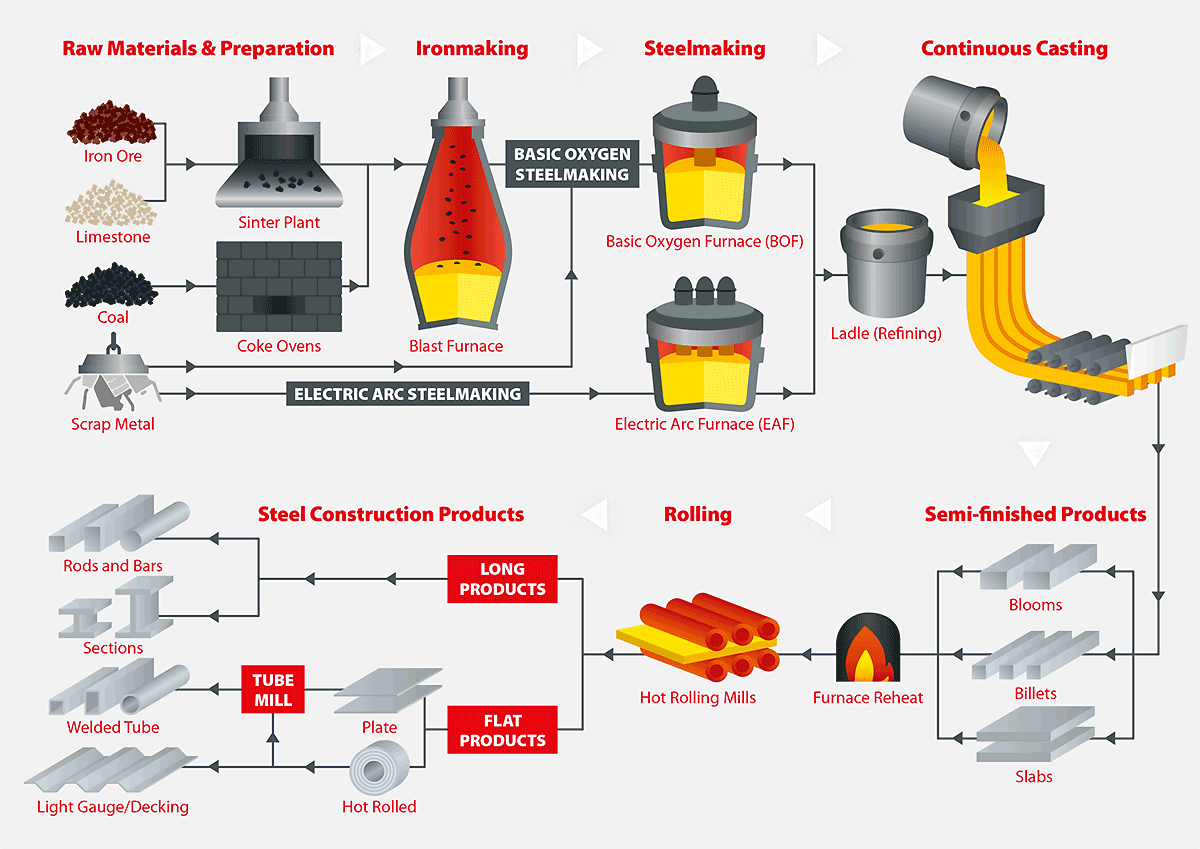Removing Carbon From Iron Creates Steel


Steel is the world's most popular construction material because of its unique combination of durability, workability, and cost. It's an iron alloy that contains 0.2-2 percent carbon by weight.
According to the World Steel Association, some of the largest steel producing countries are China, Japan, US, and India. China accounts for roughly 50 percent of this production.
The world's largest steel producers include ArcelorMittal, China Baowu Steel Group, NSSMC Group, and HBIS Group.
Steel manufacturing equipment is typical of enormous line systems that operate continuously, 24 hours a day. The bearing is one of the machine parts that supports the high-reliability of the system. NTN is working on the creation of part technologies that realize ecology and economy for various parts of the. The process starts in the center of the wheel with the three main ingredients of iron in the form of iron ore, coke and lime, which are fed into a blast furnace to produce molten iron. The molten iron is mixed with recycled steel scrap and further processed in a basic oxygen furnace to make steel. The electric arc furnace melts recycled steel scrap.
The Modern Steel Production Process
Methods for manufacturing steel have evolved significantly since industrial production began in the late 19th century. Modern methods, however, are still based on the same premise as the original Bessemer Process, which uses oxygen to lower the carbon content in iron.
Today, steel production makes use of recycled materials as well as traditional raw materials, such as iron ore, coal, and limestone. Two processes, basic oxygen steelmaking (BOS) and electric arc furnaces (EAF), account for virtually all steel production.

Modern steelmaking can be broken down into six steps:
Ironmaking, the first step, involves the raw inputs of iron ore, coke, and lime being melted in a blast furnace. The resulting molten iron also referred to as hot metal still contains 4-4.5 percent carbon and other impurities that make it brittle.
Primary steelmaking has two primary methods: BOS (Basic Oxygen Furnace) and the more modern EAF (Electric Arc Furnace) methods. BOS methods add recycled scrap steel to the molten iron in a converter.
At high temperatures, oxygen is blown through the metal, which reduces the carbon content to between 0-1.5 percent. EAF methods, however, feed recycled steel scrap through use high-power electric arcs (temperatures up to 1650 C) to melt the metal and convert it into high-quality steel.
Secondary steelmaking involves treating the molten steel produced from both BOS and EAF routes to adjust the steel composition. This is done by adding or removing certain elements and/or manipulating the temperature and production environment. Depending on the types of steel required, the following secondary steelmaking processes can be used:
Mild Steel Manufacturing Process Pdf
- Stirring
- Ladle furnace
- Ladle injection
- Degassing
- CAS-OB (composition adjustment by sealed argon bubbling with oxygen blowing)
Continuous casting sees the molten steel cast into a cooled mold causing a thin steel shell to solidify. The shell strand is withdrawn using guided rolls and fully cooled and solidified. The strand is cut into desired lengths depending on application; slabs for flat products (plate and strip), blooms for sections (beams), billets for long products (wires) or thin strips.
In primary forming, the steel that is cast is then formed into various shapes, often by hot rolling, a process that eliminates cast defects and achieves the required shape and surface quality. Hot rolled products are divided into flat products, long products, seamless tubes, and specialty products.
Finally, it's time for manufacturing, fabrication, and finishing. Secondary forming techniques give the steel its final shape and properties. These techniques include:
Steel Tank Manufacturing Process Pdf
- Shaping (cold rolling), which is done below the metal's recrystallization point, meaning mechanical stress—not heat—affects change.
- Machining (drilling)
- Joining (welding)
- Coating (galvanizing)
- Heat treatment (tempering)
- Surface treatment (carburizing)